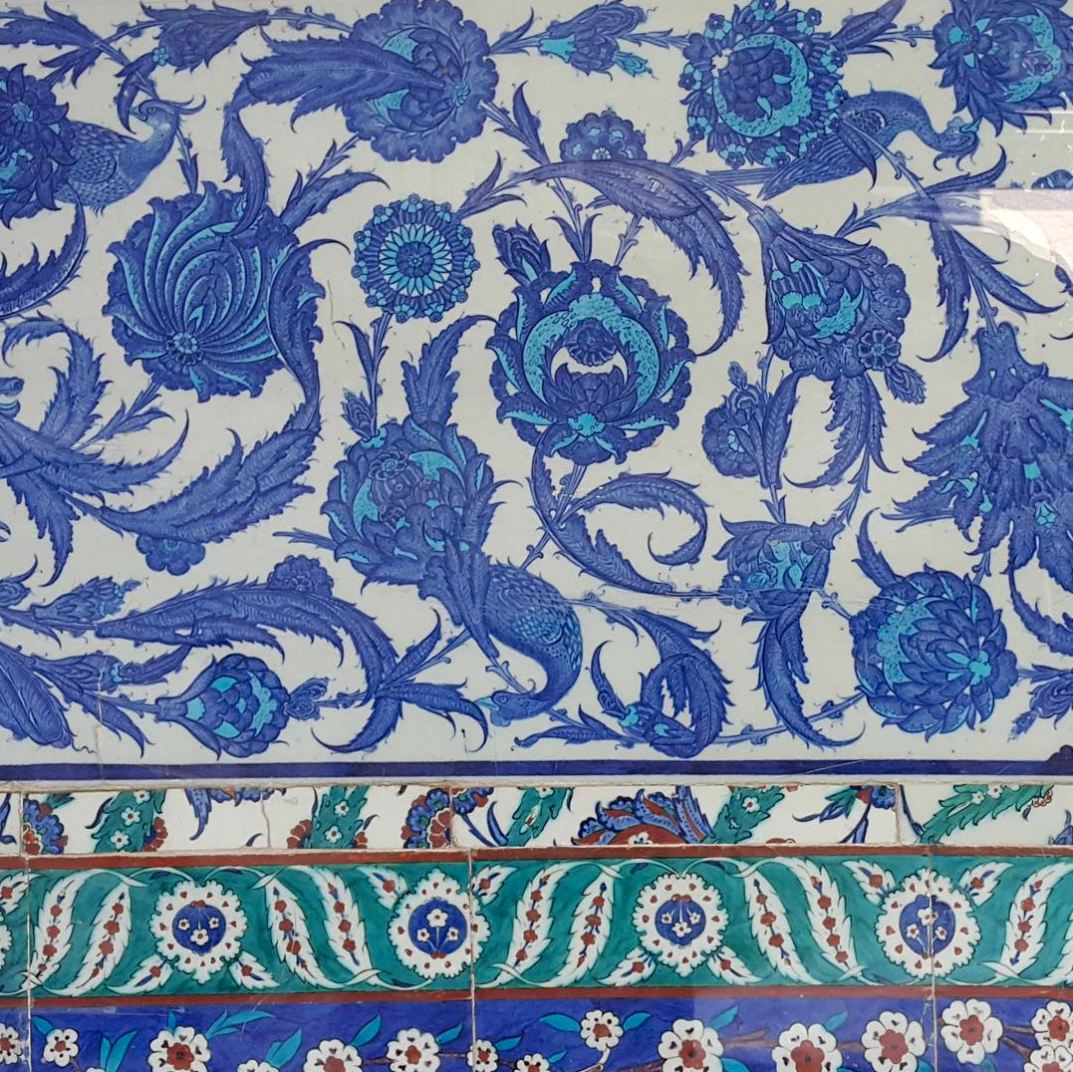
çini
Pronounced Chini
Ceramics has been one of the most important artistic interactions between civilisations. In existence since 28,000 BCE, the craft advanced with China’s invention of the first high-temperature kiln and porcelain in the 7th century, both of which shaped almost all Asian and European ceramic arts.¹ Chinese stylistic influence on ceramics trailed along the land that stretches from the Middle East to Spain, showing differences depending on time period and location.²
Çini is the modern name we give to traditional glazed ceramics made in Turkey, commonly referred to as ‘Iznik Tiles’ in the West. Generally featuring colourful motifs of plants, animals and geometric patterns, they are found decorating monumental buildings as well as objects in homes throughout the country.³
Çini-making includes an intricate process where a design is drilled on paper and transferred to the surface of the fired object (e.g. tile) using coal dust, before painting, glazing and second firing takes place.³ Production involves many people, each with a specific role – shaping, design and dye, polishing and undercoating or firing.
This style of ceramics can be traced back to the Turkic Kara-Khanids Empire of the 10th century, growing in popularity from then on, especially during the Great Seljuq Empire, peaking during the 16th century Ottoman Empire with dedicated centers in Iznik and Kütahya.⁴
In the early period, çini were painted blue and white, and featured arabesque scrollwork with influences from Chinese porcelain motifs. As for the forms, although some of them can be attributed to Chinese porcelain, the greatest influence was highly regarded Ottoman metalware, spreading its influence, also, to decorative aspects of çini.⁵
Iznik Çini were made under the patronage of the Sultan, and so struggled to keep running with the decline of the Empire, shifting the main production to Kütahya, where there was sufficient resources for raw materials. Kütahya had been making çini to meet the needs of the public, which made their production more stable.²
By the end of the 18th century, Armenian masters living in Kütahya became prominent makers of the craft, adapting the stylistic elements according to their values, and using yellow, which wasn’t available in Iznik. Çini of this period included male and female figures, church and cross compositions. The synthesis is evident from the many Armenian churches decorated in çini. Kütahya çini industry was established in Jerusalem in 1919 by the Armenians of Kütahya and the craft evolved once again, this time across the Mediterranean.²
Today, we estimate more than 5000 makers of çini in Turkey alone⁶, maintaining an art form that is a symbolic aspect of Turkey’s cultural identity, strengthening links from the past to the present.³
[1] ‘A Brief History of Ceramics and Glass’ via ceramics.org |[2] ‘Çini Sanatının Medeniyetler Arası Etkilesimdeki Rolü’ by Çetin Öztürk and Zeyneb Baysal |
[3] ‘Traditional craftsmanship of Çini-making’ via ich.unesco.org | [4] Türk Çini Sanatı ve Tarihçesi via armadacini.com |
[5] Hülya Bilgi, The Omer Koç Iznik Collection, 2015 | [6] Geleneksel Çini Ustalıgı via gezialemi.com
Visual Credits - Banner: @deryasoyyigit, Thumbnail: Pedro Novales
Below gallery (starting with the building exterior, going right):
[1] Cinili Cami, Kütahya - Unknown photographer | [2] Hakki Cinicioglu ve Ahmet S. Sahin, Kütahya, 1928 - Photo Courtesy of Murat S. Sahin Archives |
[3] N/A | [4] Konya Çini Eserleri Muzesi - Photo Courtesy of Turkishmuseums.com | [5] Photo Courtesy of kuveytturkozel.com.tr |
[6] Üsküdar Çinili Cami - Photo Courtesy of camilerveturbeler.com | [7] Topkapi Palace Photo Courtesy of Meric Dagli |
[8] Ahmet S. Sahin ve Faruk K. Sahin, Kütahya, 1967 - Photo Courtesy of Murat S. Sahin Archives | [9] 16th century Iznik Vase - Photo Courtesy of V&A |
[10] Çini decorated oven exterior - Photo Courtesy of gezialemi.com















